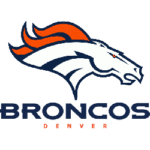
Denver Broncos Primary Logo 1962 - 1969
It is no secret that the Denver Broncos have had a storied history ever since they started as a charter member of the AFL in 1960. They became associated with the NFL as part of the AFL-NFL merger in 1970. The Broncos have won over 10+ division championships in their history. After losing their first four Super Bowl tries, the Denver Broncos would win back-to-back Super Bowl championships in 1997 and 1998 over the Green Bay Packers and the Atlanta Falcons. They would another Super Bowl victory in 2015. Great players such as John Elway, Terrell Davis, Shannon Sharpe, and Peyton Manning
The Denver Broncos have had many logo changes throughout the history of their franchise. Let’s go over the logo history of the Denver Broncos.
There is no secret that the Denver Broncos logo history is vast. Their first logo involves a football player wearing a brown and mustard yellow logo jersey. The helmet worn on the football player is also mustard yellow. The football player in the logo is riding a bronco that is also yellow. The bronco is in the midst of bucking. The logo has a white background. The logo was in existence for only two years.
In 1962, the Broncos unveiled another primary logo with a different color scheme of orange, white, and royal blue. The new logo had a football player holding a football while wearing a uniform in the aforementioned color scheme. He was riding a bucking Bronco that is colored orange.
During the same time, the Broncos came out with the alternate logo that was similar to the primary logo that was just described. The only difference is that they had a blue shield that said: “Go Broncos Go” in white. Both logos lasted from 1962 -1969.
During that time, the Broncos introduced a new wordmark logo. It simply says “Broncos” in blue font. This wordmark logo lasted until 1996.
In 1970, the Denver Broncos would adopt a logo that would last them for over two decades. While they maintained the color scheme of the last logo, this logo was highlighted by a letter “D” in orange. A white horse is contained within the orange-colored “D.” One can see that there is steam coming out of the horse’s nose. The horse’s hind legs are in the air.
In 1993, the Broncos would slightly modify their logo. They kept the orange-colored “D” and the white horse contained within the “D.” However, there were subtle changes in the outlines and facial features contained within the white horse. This logo lasted until 1996.

Denver Broncos Alternate Logo 1997 - Present
In 1997, the Denver Broncos would drastically change their primary logo. It is the head of a white horse. The white horse’s head contains an orange-colored mane. The franchise would keep orange and white as part of their color scheme. However, this new logo has navy blue as part of its color scheme. Navy blue outlines can be in the horse’s mane and face. This is still Bronco’s primary logo today.
During that same year, the Broncos updated their watermark logo. It consisted of a tiny “Denver” wordmark in orange. However, the bigger “BRONCOS” color in navy blue is the highlight of that magazine.
Additionally, there were two alternate logos that debuted in 1997. The first alternate logo was a combination of the primary logo on the top and the navy blue “BRONCOS” wordmark on the bottom.
The second alternate logo is a logo of a bucking bronco. However, the full body of the bronco can be seen in this logo. One can see that this bronco has an orange mane. A navy blue outline can be seen all around this logo.
 Sports Logo History
Sports Logo History Sports Logo History is a community of sports logo enthusiast who enjoys the history of each team’s logo history. Sports Logo History has primary logos, alternate logos, wordmark logos, or concept logos from the NFL, NBA, MLB, MLS, NHL, Premier League, WNBA, CFL, NCAA, ABA, USFL, AAF, and XFL.
Our partner site is Sports Team History takes a look at the history of each and every professional sports team. In addition, we have added Sports News History to our sports history websites. 24/7 non-stop sports news that's worth knowing. Finally, the premier sports team marketplace for your favorite team or college with thousands of items for you to peruse at Sports Market History.

